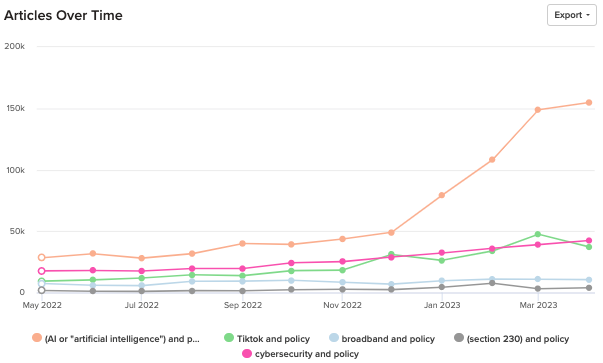Congressman Maxwell Frost is 26 years old. During a speech to fellow Democrats, he called a popular political event held in South Carolina “the Coachella of the South.” As he recalled to MSNBC host Jen Psaki recently, half of the crowd had no idea what he was talking about.
A similar Congressional caricature describes elected officials’ understanding of technology. One could assume Maxwell Frost has used TikTok; one could also assume that puts him in an extreme minority within the House.
TikTok is just one of several technology-related issues facing policymakers. As another example, on the cybersecurity front, the recently released White House Cyber Strategy challenges software producers to ensure their applications are secure.
But the topic that has moved to the forefront of recent tech policy debates is artificial intelligence. OpenAI’s introduction of ChatGPT has captured everyone’s imagination, including lawmakers. While AI has been around for a long time, discussions of its benefits and concerns have increased dramatically in the wake of the recent generative AI advances.
To its credit, the public sector is taking notice. The White House recently announced it would sponsor a hackathon at the DEF CON security conference in August, where hundreds—potentially thousands—of hackers will test AI to catch problems with emerging AI methods. Even more recently the CEO of OpenAI called on Congress to adopt safety standards.
Here are four key takeaways for tech communications leaders regarding the current state of the AI policy debate:
- AI has pulled ahead within the crowded tech policy dialogue. An agenda for the recent State of the Net event shows a variety of issues on the minds of inside-the-beltway influencers, including tech competition, broadband adoption, security, privacy, Section 230, digital equity, and AI. One of the sessions focused on TikTok. However, AI has taken off as the leading topic in stories that mention policy.

- Policymakers are open to a dialogue with tech leaders. More than one time, speakers at the State of the Net conference stressed how they were open to discussing technology developments to create policy that will encourage innovation while protecting key audiences (including both businesses and consumers).
- The attention is international. The EU has introduced the European AI Act, a preliminary mandate to limit the potential negative impact of AI developments. The Act includes thinking regarding the development of high-risk systems and the use of biometric information, as well as provisions to ensure the protection of copyright laws.
- Don’t expect a sweeping policy edict in the U.S. The American policy process is designed to work slowly. The current intractable political divides in Congress bring the process to a halt. Congress has been trying to enact data privacy legislation for a long time, and it arguably is not closer now than it was when it started.
| Learn about strategic communication services |
A reasonable expectation, as argued by R Street Institute Senior Fellow Adam Thierer at the State of the Net event, is what he calls “soft-law” governance for emerging technologies, where the public sector brings stakeholders together and creates “rough rules of the road for [AI] governance in real time.” Such an approach has worked on other issues and tends to be non-partisan, something needed during the time of Congressional gridlock.
Public sector involvement in AI discussions is not a surprise, given the often apocalyptic predictions of its impact on our society. That involvement means that any B2B tech PR program must consider public-sector communications for two key reasons.
First, as noted, U.S. policymakers are asking for input. Both they, and the influencers who reach them, want to hear from experts across the spectrum. Policymakers want to get it right, considering actions that will protect consumers but stay out of the way of innovation (as much as possible). Thierer spoke to his hope that an initial NIST framework regarding proper AI use will encourage vendors to educate wide audiences on the topic.
Second, given the dramatic implications of public-sector involvement, technology leaders need to be ready to respond. As a pre-emptive communications strategy, tech companies should consider putting a stake in the ground about their own ethical use of AI — both to educate the market and to stay ahead of potential policy requirements.
In summary, the rising intensity of conversations about AI increases attention to the relationship between the public sector and the technology industry. Companies that plan their communications approach to policymakers can benefit by extending their own thought leadership positions.
